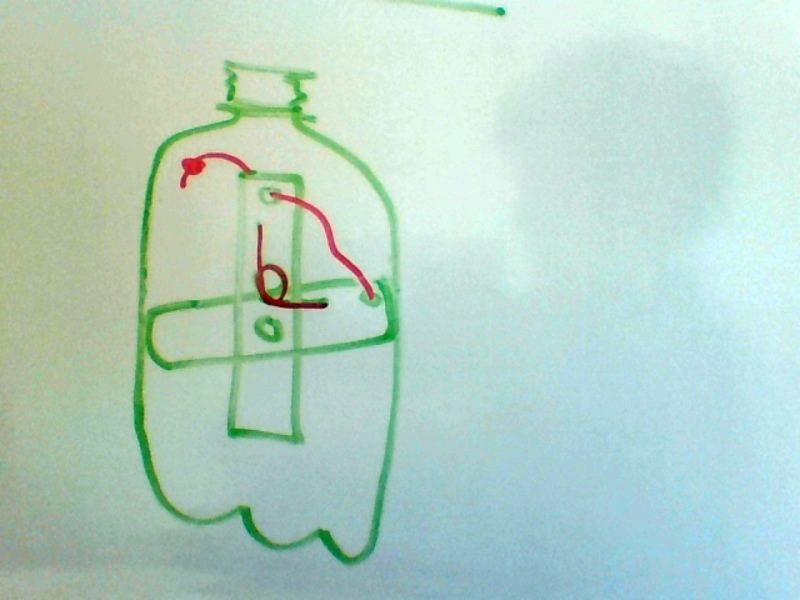Re: ooooh idea re: turbidity
Mathew Lippincott
Wouldn’t the LED illumination be swamped by ambient light? Easy solutions are to measure only at night or to put the whole thing in an opaque container. A simple shield around the LED/detector pair could also work, but not with a clear water bottle.
Another possible issue is that the clear plastic of the water bottle will transmit some light sideways to the detector, but that should be minimal.
The spring loaded cross piece could work well, deploying only after the unit is inserted into the bottle. Have you thought about how you would get it back out of the bottle? Possible, but messy.
A bigger issue might be that you would be designing a part that worked only with a certain type of water bottle. As John Keefe has shown, alternate containers are going to be required for alternate forks of the Riffle. And everyone is going to want a Fona.
Note that the Gatorade bottles John used have very deep surface indentations. These could allow the LED to point at 90° to the detector. But arranging things inside a water bottle is a pain.
Why invest months (years) of highly technical and precise design effort on the Riffle but refuse to consider anything but a flimsy found object for its container?
Is it time to think outside the bottle?
Chris
Why is this a private conversation?
From: donb...@gmail.com [mailto:donb...@gmail.com] On Behalf Of Don Blair
Sent: Wednesday, October 07, 2015 1:20 PM
To: Mathew Lippincott; to...@publiclab.org; gret...@publiclab.org; Fastie, Chris; Craig Versek
Subject: ooooh idea re: turbidity
When I showed up to breakfast in Portland at (Theo's?) the other morning, Mathew and Tony were talking about a spring-loaded crossbar geometry for securing the Riffle inside a bottle, so that it didn't move around much.
It occurred to me this morning that for a turbidity alert system, we don't really need to measure 'standard turbidity units' (on which anyway there doesn't seem to be very uniform agreement, and which Gretchen informed me this morning -- if I've got this right, Gretchen? don't anyway have associated unit-specific regulations) -- we just need some measurement that gives us a sufficient proxy for significant changes in turbidity. This reflects conversations I'd had a year ago with hydrologists, who seemed to think that, due to fouling and differences among instruments, turbidity measurements weren't very trustworthy beyond detecting big changes.
Here's an idea: a spring-loaded crossbar (likely a circuit board) connected to the Riffle (in the middle?) that, in its equilibrium position, creates a 'T' shape with respect to the Riffle. At one end of the crossbar, pressed up against the inside of the water bottle, is an emitter/detector pair: an LED and a photoresistor (or other light detector), perhaps separated by a small baffle, both oriented so that they point out of the bottle. We can play with the angle; there is research to suggest that having them at about 90 degrees is optimal, but there might be issues re: the curved plastic surface.
I'd wager that if we can find a way to keep this fairly rigid up against the side of the bottle -- a strong spring, and maybe rubber tips on the crossbar so that the crossbar really digs in / fits snugly against the sides -- we could do the following with the bottle underwater:
(1) with LED off, measure the light level (baseline)
(2) with LED on, measure the light level
(3) subtract (1) from (2) to get our 'turbidity proxy' measurement
The amount of light measured this way should be influenced by the amount of suspended solids in the water. It's actually not far away from how one might go about measuring turbidity with a more sophisticated design (though one would prefer to use a flat 'window' instead of the curved bottle surface).
Further, this means that we could manufacture a custom mechanical part cheaply -- the crossbar would just be another PCB, with holes appropriate to the kind of spring we'd want.
What really appeals to me about this is that it would allow us to make turbidity measurements without constructing an elaborate 'water passing through a pipe, which is surrounded by electronics, which is surrounded by sealed pipe' device, with lots of failure points; everything is inside the bottle. And as long as this 'turbidity proxy' design was stably held inside the bottle against the side so that its orientation didn't change over time, I think we'd have just as much of a shot at getting good turbidity-proxy readings as we would any other way.
It's anyway something that can be prototyped fairly easily by sticked an emitter / detector pair inside a bottle and sticking it to the side with putty or equivalent (temporary, but good enough for a short experiment), and seeing whether we can detect changes in turbidity that mimic the changes they're talking about in Wisconsin ...
Jeffrey Warren

--
Post to this group at plots-wat...@googlegroups.com
Public Lab mailing lists (http://publiclab.org/lists) are great for discussion, but to get attribution, open source your work, and make it easy for others to find and cite your contributions, please publish your work at http://publiclab.org
---
You received this message because you are subscribed to the Google Groups "plots-waterquality" group.
To unsubscribe from this group and stop receiving emails from it, send an email to plots-waterqual...@googlegroups.com.
For more options, visit https://groups.google.com/d/optout.
Chris Fastie
Jeffrey Warren

--
Don Blair
Don Blair
Chris Fastie
Mathew Lippincott
I totally want a Riffle and a FONA. Can you bring one to LEAFFEST to trade for a SkyShield and pickles?
--
